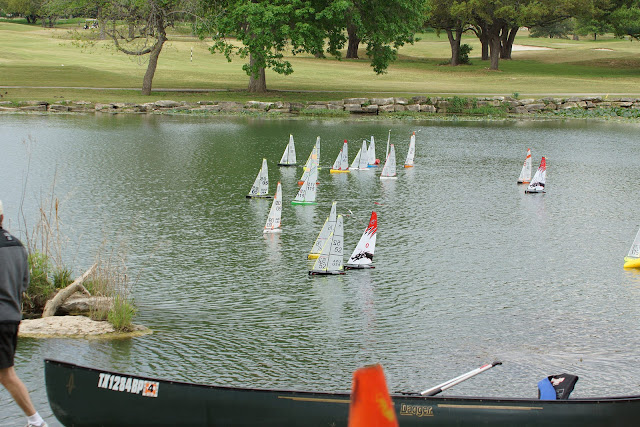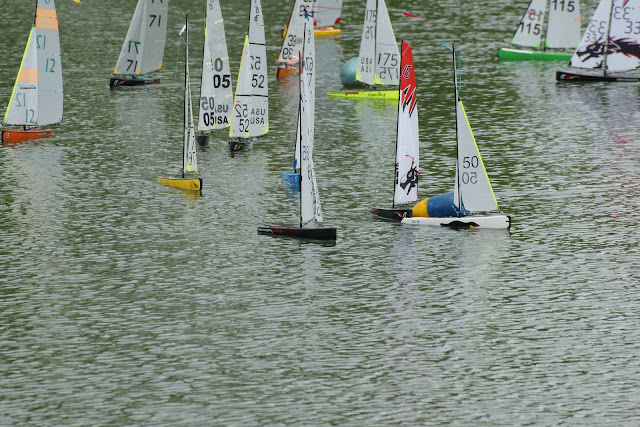Since its origin the DragonForce-65 (DF-65) has been propounded in two classes; first as a one-design boat, and second as a fully class compliant RG-65. In the US the DF-65 was originally registered as an RG-65, and many regatta's took on one of two formats; one-design DF-65's (only) or raced in RG-65 events, typically with separate scoring. This separate scoring was usually done on the grounds that there was essentially two intermingled regattas, one for RG-65's and the other for DF-65's. Even with this "one fleet two scoring" system, a DF-65 would still place in the RG-65 event; for example, Chris Macaluso won last year's White Rock Cup in both the DF-65 and RG-65 categories. As the DF-65 is now being organized as its own one-design class in the US, separate from the RG-65 (though, still fully, at this writing, RG-65 legal), the question naturally arises, once organized into their own class, should the DF-65 continue in the "one fleet two scoring" manner in which it began when participating in RG-65 events? The determining question therefore, would obviously would be, is the DF-65 competitive enough in the RG-65 to be worth sailing as a typical RG-65? As I intend to demonstrate, the answer is a qualified "yes".
First, it should be understood that no boat in an open ecosystem necessarily remains competitive forever...one need merely look at the IOM class, where the largely successful wide-beam skiff designs (like the "TS-2") have all but disappeared in favor of narrower, partial chine boats like the "BritPop". Technology marches on, and it is generally not given to any design to stay on top forever...
Secondly, as a caveat to the above observation, it is also well understood that a good skipper with a well-tuned old boat will usually beat a poor skipper with a poorly worked-up new one.
Assuming all other things are equal for the purposes of this argument, can a DF-65 race with a typical RG-65 with a reasonable chance of success? I say yes, for reasons I shall now explain. First, let's take a look at some particulars; I'll compare my DF-65 to my RG-65 (a Blue Splash, a typical RG-65 design with swing-rig). Both boats are, of course 650mm long, and are of very similar beam (within a few mm). On my boat at least, the keel is carbon fiber and 650 grams of lead in the bulb, and about the same length (again a few mm shorter); the DF-65 has metal fin and a 554g bulb. In terms of hull shape, the DF-65 shows a strong "U" shape with a flatter sections heading aft, while the Blue Splash evinces a more "V" shaped hull with a rounder transition aft.
 |
| General profile, both in A-rigs...the Blue Splash is a bit deeper and more rounded. |
 |
| Characteristic U-shape of the DF hull, allowing for a flat transition aft. |
 |
| The V-shape of the Blue Splash (bow bumper not installed) showing a deeper entry and rounded aft transition. |
In terms of hull, form and foil design, the DF-65 and Blue Splash represent different thinking and different trade-offs, I believe it is fair to say neither design approach is intrinsically superior. Specially, given that both boats use their maximum waterline (a key speed component), they are both able to reach hull-speed fairly easily in a breeze (at hull speed, the amount of power from the rigs can't move the hull any faster, typically causing nose-diving. The solution, is of course, to reduce power by using a smaller rig or sailing a different course to bleed out the excess power).
The real differences in these boats lie in two areas: weight, and rigs.
A typical, ready to race DF-65 usually comes in at about 1250 grams, with a plastic hull and rudder, and metal keel fin.
By comparison, the Blue Splash has a fiberglass hull and carbon fiber keel fin and rudder and weighs about 1130 grams, about 100 grams or so lighter, and some RG-65's will weigh even less. It is important to keep in mind that RG-65's are made out of a variety of materials; wood/balsa, fiberglass, plastic, and carbon fiber, so in terms of materials it is difficult to generalize.
The key performance take away here, is that a typical RG-65 will be lighter and carry a heavier keel-bulb; allowing for less weight to move under sail and a greater righting action to carry a taller rig. This leads to, in my opinion, the definitive differential; rig plans.
 |
| The tall, narrow, high-aspect A-rig carried by the Blue Splash compared to the more conservative A-rig of the DF-65 |
 |
| The Blue Splash B-rig here is about 85% of the DF-65 A-rig, and fairly similar. |
By carrying more weight down low in the keel-bulb (nearly 100 grams more), the Blue Splash carries an A-rig nearing the maximum allowed height and sail area, in a very efficient, high-aspect form. By contrast, the DF-65 favors a much more conservative, lower-aspect rig, only about 15% larger than the B-rig of the Blue Splash (see above photos). I suspect the heavier plastic hull of the DF-65, combined with a keel bulb nearly 100 grams lighter, would make a taller rig impractical, and quite tender in anything short of a very light breeze. It should be noted, that in this comparison, the Blue Splash is carrying a swing rig as compared to the DF-65 traditional fractional rig...I will have more to say about this later, but the choice of swing-rig vs. fractional is not determinative in my opinion, many successful RG-65's sport fractional rigs also.
The rub of the matter, as I see it, is what are the competitive advantages of these rig differences? Simply out, the larger sail area and more efficient high-aspect form of the Blue Splash A-rig, generates more power for a lighter boat, making it faster than the DF-65. There are important caveats, however.
The A-rig pictured above is good up to about 9 mph wind speed before it begins to over-power and require a downshift to the B-rig. The DF-65 can continue to sail it's A-rig quite comfortably in this wind range, and in my experience, it can carry its A-rig to about 15 mph...so from 9 to 15 mph the DF-65 is sailing with about 15% more sail than a typical RG-65...sail area being horsepower, this has a very leveling effect on speed. This squares with my own experience; when I'm sailing my A-rig against DF-65's, I have a noticeable speed advantage, particularly running downwind. In that DF-65 "sweet spot" of 9-15 mph, I'm the one with less sail area and do not see any noticeable speed advantage. As wind speed increases beyond 15 mph, both boats start hitting their maximum hull speed fairly easily, and again, there is little advantage. Given the size of the DF/RG-65, speed will level off rapidly as the wind speed increases beyond 9 mph, regardless of rig. So in terms of advantage, it is my opinion that the RG-65's are advantaged in winds below 9 mph, and the boats are increasingly equal as the wind rises beyond that point.
I note that this comparison is based on my RG rigs, the kits & sails of which were produced by Eric Rosenbaum, and constructed by me. For comparison, other boats may have very different rigs...however the ones I've described are by no means atypical. For example, I have considered an "A-" rig that would be lower aspect as compared to my current A, but of nearly the same area, to shorten the "9-15mph" gap I described. If executed successfully it may push the DF-65 into a narrower, higher, wind band of competitiveness.
Also, a note about swing rigs...some consider the DF-65 disadvantaged because it carries a fractional rig. I think this misunderstands the advantages (and drawbacks) of the swing rig, and fails to account for the many highly competitive boats that use a fractional rig. The advantage of the swing rig, is, in my opinion primarily it's tremendous efficiency running downwind, especially in light air. Typically, in lighter air, if you have two identical boats; one with a swing rig and the other a conventional fractional rig, the swing rig will be noticeable quicker downwind (the physics of why are for another article). Going upwind, the swing rig is a bit faster, but also sails a bit lower, which is essentially a push, though in small boats like the RG-65 sailing high can be slow and dangerous! In my B-rig I have trouble with the DF-65 when they are still in the A-rig heading upwind, I'm not really faster and they will typically be sailing a bit higher. On any reaching course a swing rig is difficult to trim properly; it is also a bit different to tack and requires some adjustment of technique (you do not ease the sheets and then tighten back up to accelerate like a fractional rig). Suffice to say, a swing rig represents a preference more than an serious competitive advantage, its primary value being (as stated) in light air downwind legs.
So to answer the question I began with, can a DF-65 be raced competitively with a "typical" RG-65? I would give a qualified yes, it is most competitive in wind ranges exceeding 9 mph. Some have suggested to me that in venues with greater wave action, the taller rig RG-65 rig "whip saws" more, making a figure of 7 mph more realistic). In these conditions, I believe the skipper skill and rig tune will prevail, i.e. the boat is competitive and the better sailor and rig tune will prevail. Below these wind speeds, the DF-65's greater weight, smaller righting action, and low aspect rig will make it more challenging. As every boat is designed for some optimal condition, I would therefore consider it reasonably competitive.
I therefore believe a DF-65 is a proper and reasonably competitive RG-65 and can generally be raced and scored as such.
I hope this has proved helpful and I invite the thoughts of others...





























